2018 was a brutal year for the farmed animal movement, with the publication of article after article after article after article detailing bad behavior by some of the most prominent men in the movement. The reported conduct ranged from bullying to sexual assault, much of it committed against subordinates. (Full disclosure: I worked for the Humane Society of the U.S. at the time these allegations came to light. I know many of the women involved, and believe all of them.)
For most of the people I know in the movement — especially most women — the deluge of stories of sexual harassment has spurred discussion of whether there is a sexism problem in the farmed animal movement. That’s particularly the case because the accusations involved not bit players in the movement, but rather men who were leaders or co-founders of some of the most renowned organizations working on farmed animal issues.
Many people in the farmed animal movement are now asking: where are we on gender diversity, equity, and inclusion? And how can help ensure that all genders have an equal ability to succeed in the movement?
Where are we as a movement?
In order to discuss where we should be as a movement, I think it’s helpful to take a moment to determine where we are. Using publicly available information, except where otherwise noted in the source data, I’ve informally surveyed the leadership and boards of directors of the largest organizations in the global farmed animal movement. (Source data is here.)
In order to establish a baseline, I also surveyed four of the largest farm animal groups in the US movement on the gender breakdown of their staff. All four of the groups reported that either 69% or 70% of their organizations were comprised of women (none of the groups surveyed provided numbers of non-binary persons).
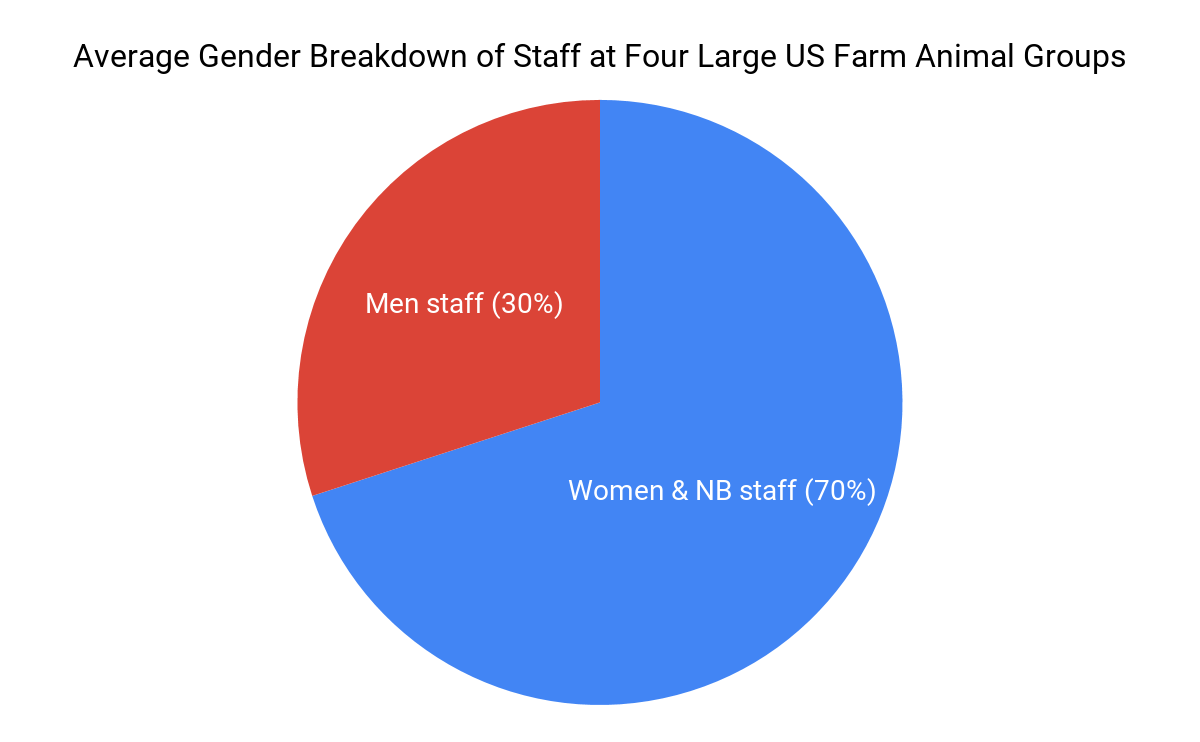
I was more exhaustive in my surveys of boards of directors and leadership teams. Specifically, I looked at all organizations that spent $1 million dollars or more on farmed animal advocacy in 2017 (excluding groups that are primarily animal sanctuaries; I also did not count certification organizations as “advocacy” groups). Fifteen US-based and ten international groups met this criteria.
I first looked at the leadership at each of these organizations. Internationally, four out of ten organizations were led by women; in the US, six out of fifteen were. (Note that I refer throughout to women and men, because to my knowledge none of the leaders or board members of the largest organizations are nonbinary.) All groups incorporated in the US are included in “US groups” category, even if they do substantial activities internationally. That is because most of their leadership teams are US-based, and thus more relevant for a US analysis. Humane Society International and The Humane Society of the United States are counted together because they currently share leadership. CIWF and CIWF-US are also counted together.
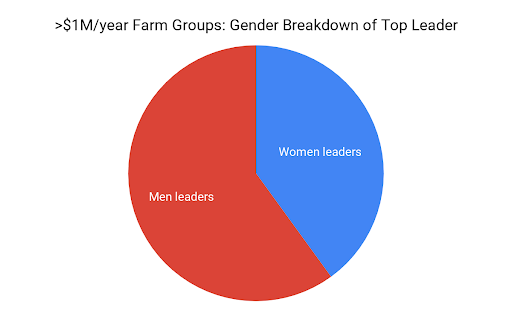
The figures here look much worse if we consider how overrepresented women are in these organizations generally — the number of women leaders is nowhere near proportionate to the number of women staff.
I next looked at the composition of boards of directors. For organizations that have multiple boards of directors (e.g. because they operate out of multiple countries), I combined the members of all boards. You’ll see that international groups had better women representation.
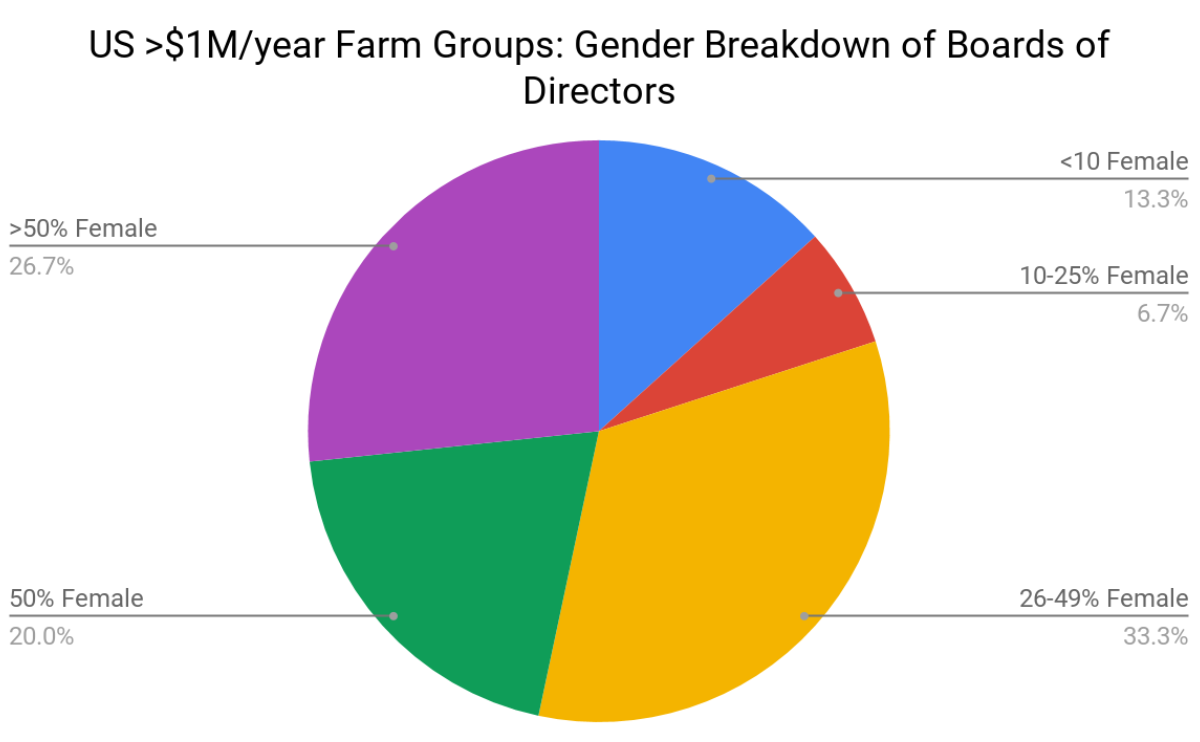
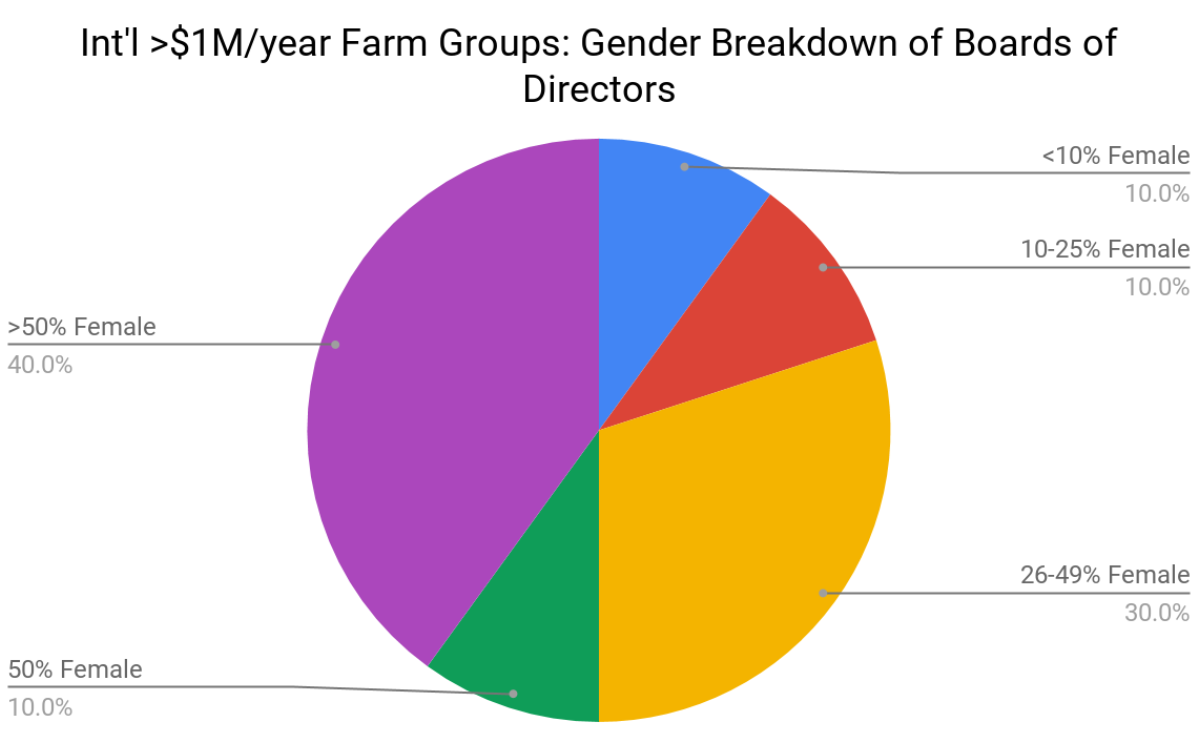
Finally, I looked at the composition of the top five staffers in each organization (excluding the CEO/President). Where groups have dedicated farm staff, I looked at the gender of the top five farm-focused staffers. Any staff who fell into this category I dubbed an “executive” — I then compared the number of total women executives to total men executives.


The executive results were interesting: both internationally and domestically, the percentage of women in an organization was much higher than the percentage of women executives; but the percentage of women executives was higher than the percentage of women leading organizations. Something, the data suggests, might be happening to reduce the proportion of women through each layer of leadership.
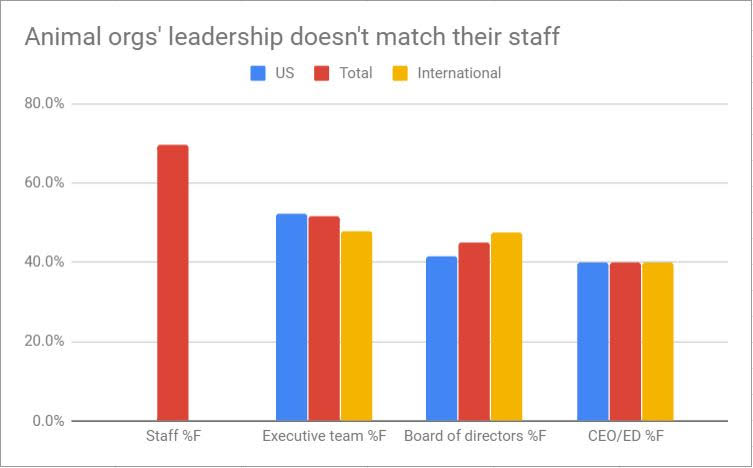
What best practices can we apply?
Taking as a given that we want to ensure women have as much ability as men to succeed in the movement, what can we do to help make the field more equitable? I’ve spent the last several months speaking to smart, thoughtful people about ways to improve gender diversity and inclusion in the movement. The refrain I’ve heard over and over is that there is no silver bullet -- no one solution that an organization can implement to magically improve gender equity. But there are some best practices that can at least help.
Combating implicit bias
Many people I’ve spoken with note that women are a large percentage of the ranks of the farmed animal movement, but a much smaller percentage of its leadership. The early research I’ve done confirms that, suggesting that women are either not being promoted at the same rates as men, or are opting out of promotional opportunities. If it’s the former, there are things managers can do to attempt to combat implicit bias in performance evaluation.
Proposals to reduce implicit bias in performance reviews include:
- Give feedback based on objective criteria (especially tied to specific results or skills);
- Give all employees more frequent feedback; and
- Write performance reviews of similar lengths for all employees.
Other women leaders I’ve spoken with have also stressed the necessity of seeking out strong women advocates, and encouraging them to apply for positions of power within an organization. They also said they found it helpful to make sure job descriptions for executive-level positions list only absolutely necessary qualification requirements; in their experience, diverse qualified applicants were less likely to apply if they did not meet all of the qualification requirements, even if they would be excellent at the position.
Concrete policies to implement
There are other concrete policies that organizations can implement to improve gender inclusion and equality. One of the most basic is pay equity. There are a number of ways organizations can try to ensure better pay equity, including:
- Listing pay ranges in job postings and declining to set salary based on job applicants’ salary history;
- Conducting pay equity audits (preferably done by outside experts);
- Looking not just at pay equity across similar roles, but looking also at the average salary of men employees versus the average salary of women and nonbinary employees, to help evaluate if the organization is disproportionately putting men into higher-paying roles (organizations taking this route may wish to first consult with their general counsel);
- Having clear performance metrics that relate to salary (such as using salary grades and steps). This last point echoes a theme I hear repeatedly about gender and other forms of equity: equity is most easily achieved when evaluation criteria are clear and objective.
Organizations might consider making salary completely transparent, since women and nonbinary persons are best able to advocate for wage equity when they have information about the wages of their coworkers. Salary transparency has been used fairly non-controversially in the federal government. The practice also isn’t without precedent in the nonprofit sphere: organizations already have to disclose the salaries of officers, executives, “key employees,” and the highest-paid employees in form 990s.
Critics of pay transparency argue that it can cause discontent, especially among lower-paid employees who had believed they were high-performing. But if lower-paid employees really are high performing, they should be discontent, and the solution is not to hide the pay discrepancy but to improve their pay. If the lower-paid employees are not high performing, then they should know that, so they can improve or find a better fit elsewhere.
The European farmed animal group Otwarte Klatki has already moved to making all salary information transparent, and the group’s President, Dobroslawa Gogloza, considers the initiative a success. The group has shared with all employees both the way it calculates salaries, as well as the exact amounts. Dobroslawa wasn’t aware of any discontent the new policy had caused among employees.
Combating sexual harassment & no more rock stars
Given the wave of sexual harassment allegations that filled 2018, I also strongly encourage all organizations to institute robust anti-harassment policies. Hallmarks of good policies include:
- Clear reporting provisions, and multiple points of contact for reporting in case victims feel uncomfortable with the primary point of contact;
- Special provisions for when there are concerns about an organization’s ability to conduct an impartial investigation (such as allegations against an Executive Director, or head of human resources);
- Mechanisms protecting victims from retaliation, as well as procedures for reporting allegations; and
- Bystander training.
Finally, the movement should be careful about centering itself around a few charismatic leaders. In 2016, women in the tech industry wrote an excellent article about the dangers of “rock stars.” When a small number of famous charismatic figures dominate movements, it can begin to seem that the rock stars are the movement, and that disciplining them for inappropriate conduct would mean harming the movement itself. That’s an incredibly dangerous posture for a movement to be in, and makes abuses of power all-but inevitable. The entire rock stars post is worth reading in full, but it highlights a few concrete recommendations, including:
- Have explicit rules for conduct, and enforce them for everyone;
- Start with the assumption that harassment reports are true, and investigate them thoroughly;
- Watch for smaller signs of boundary pushing, and react strongly;
- Insist on building a “deep bench” of talent at every level of your organization;
- Enforce strict policies around sexual or romantic relationships within power structures;
- Encourage staff members to develop social relationships outside of the organization or even outside of the farmed animal movement;
- Have a succession plan; and
- Maintain a professional workplace (without an emphasis on sexual humor or excessive drinking).
I’m struck by the fact that these recommendations, and perhaps most recommendations to promote gender diversity and inclusion, are also just good management practices. Even if the goal were not to ensure an equitable field for men and women, all managers should want to build a deep bench of talent, to have explicit rules of conduct, and to base performance reviews on objective criteria. As the movement grows, it’s to our benefit to become more professional; a better workplace not just for women, but for everyone.
